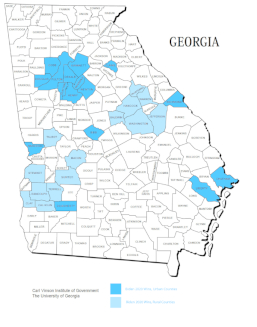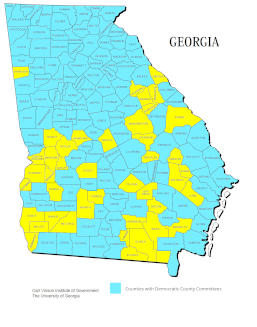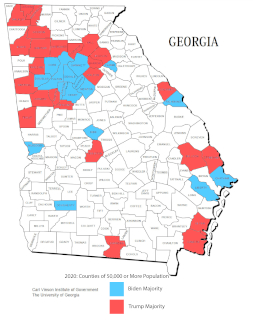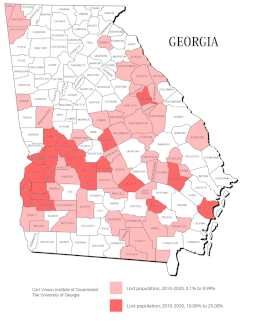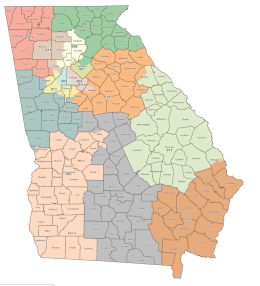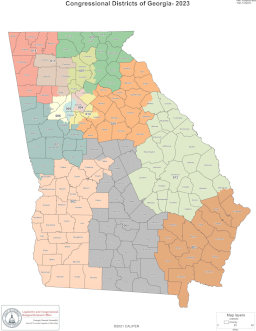Spreadsheet created in Microsoft Excel, converted to PDF format.* All 159 Georgia counties, order of sort **
- Sort 01: Counties, alphabetical order
- Sort 02: Counties, by county seats in alphabetical order
- Sort 03: Counties, by 2020 population (high to low)
- Sort 04: Counties, by 2010-2020 population change (high to low) (corrected 2023-08-14)
- Sort 05: Counties, by 2010-2020 percent population change (high to low)
- Sort 06: Counties, by 2020 population per square mile (high to low)***
- Sort 07: Counties, by 2020 Biden votes (high to low)
- Sort 08: Counties, by 2020 Biden-minus-Trump votes (high to low)****
- Sort 09: Counties, by 2020 Biden percent of total Biden+Trump votes (high to low)
- Sort 10: Counties, by (a) Rural (118) or Urban (41) designation*****; (b) Democratic County Committee exists (115) or not (44); and (c) 2020 Biden percent of total Biden+Trump votes in each combination of (a) and (b)
- Sort 11: Counties, by (a) Metropolitan designation (new column added) and (b) percent population change (2010-2020) (See "Definitions - Rural Counties" below; and both maps shown below.)
* The spreadsheet is provided here in Microsoft Excel format in the event a user wishes to sort it in a different way or use only a portion of the 159 counties.
** The column on which a spreadsheet is sorted is shown by yellow highlighting of the column title block(s).
*** No adjustment is made for land or water area that is not available for everyday use by the resident population (e.g., national parks, wildlife management areas).
**** Regarding Sort 08, in no county were there enough third-party (Libertarian) votes to alter the Biden vs. Trump winner.
***** Counties labeled in these spreadsheets as "Urban" have 50,000 or more population in 2020; and those labeled "Rural" have less than 50,000 population in 2020. See also alternative definitions based on Metropolitan Statistical Area designations, many of which contain counties with less than 50,000 population in 2020.
|
Publications, Resources
- "Rural Georgia in Focus." By David Tanner, Associate Director, Carl Vinson Institute of Government, University of Georgia, September 1, 2021 (34 pp.)
- Rural Urban Bridge Initiative
- "Can Democrats Succeed in Rural America?" Rural Urban Bridge Initiative’s Groundbreaking Report, November 2022
- "The Urban-Rural Divide: A Guidebook to Understanding the Problem and Forging Solutions." Compiled and edited by Anthony Flaccavento, May, 2020
- "A Rural New Deal." A joint publication of Rural Urban Bridge Initiative and Progressive Democrats of America, September 2023 (also archive copy)
- "To Reach Rural Voters, Democrats Need a Place-Driven Strategy." By Matt L. Barron, Barn Raiser, September 25, 2023
- NEW! (11/13/2023) "Top Rural Counties in Georgia for 2024." YouTube, ruralorganizing.org, October 9, 2023. "We discuss the top counties identified to move the progressive needle in 2024 from data-driven research conducted by Dani Cook for Ruralorganizing.org. Counties may be pivotal for either Presidential, Senate, House races or a combination of them."
- NEW! (1/3/2024) "Review: Who Is the Rural Voter? Book [The Rural Voter] Builds on Old Themes to Create New Understanding." By Olivia Weeks, The Daily Yonder, January 2, 2024. "With the help of the largest ever survey of rural voters, two political scientists explore the sources of division between rural and urban America. A heightened sense of civic pride accompanied by deep economic anxiety are two of the factors." Book, The Rural Voter, published 11/21/2023 (Bookfinder) (Amazon)
- NEW! (1/11/2024) "TDS Strategy Memo: The recently published book, Rust Belt Union Blues, by Lainey Newman and Theda Skocpol represents a profoundly important contribution to the debate over Democratic Strategy. It challenges the dominant theory for why Democrats have suffered a major decline in working class support and how they can attempt to regain it." By Andrew Levison, The Democratic Strategist, January 2024. (Bookfinder) (Amazon)
- NEW! (2/4/2024) "Rural Roadmap to 2024." RuralVote.org (RuralVote.org put together this resource to ensure progressive rural organizers can access data, research, and best practices for engaging voters in small towns and rural communities in 2024.)
- NEW! (4/11/2024) [Below] RURAL AREAS: "We say very clearly that rural America is hurting. But we refuse to justify attitudes that some scholars try to underplay."
From the article: "When we wrote White Rural Rage [Bookfinder, Amazon], we knew that our provocative argument and book title would arouse ire on the far right. We were not disappointed. But we have been surprised by the ferocity of the criticism we have received from scholars of rural politics....
"What isn't said enough is that rural whites are being told to blame all the wrong people for their very real problems. As we argue in the book, Hollywood liberals didn't destroy the family farm, college professors didn't move manufacturing jobs overseas, immigrants didn't pour opioids into rural communities, and critical race theory didn't close hundreds of rural hospitals. When Republican politicians and the conservative media tell rural whites to aim their anger at those targets, it's so they won't ask why the people they keep electing haven't done anything to improve life in their communities.
"...We argue that the return of political competition to rural areas is vital, but that will take not only Democrats making more of an effort but rural people demanding more from the Republicans who take their votes and give so little in return."
"An Honest Assessment of Rural White Resentment Is Long Overdue." By Paul Waldman and Tom Schaller, The New Republic, April 11, 2024 (Authors of 'White Rural Rage')
- NEW! (4/20/2025) "Rural communities and farmers overwhelmingly supported Trump in the last election. However, his policies—including tariff threats, cuts to agricultural subsidies, and rollbacks on rural healthcare funding—are creating new economic pressures for these very voters."
"Farmers and Working Class Voters Backed Trump, But His Policies Are Leaving Them Behind." Haystaq DNA, February 28, 2025
|
- Possible Partner Organizations
- Definitions - "Rural" Counties
- What is “rural”?
Georgia government agencies and other entities have a variety of definitions, presumably depending on the mission of the entity; so the identity and number of "rural" counties varies. A more widely recognized definition is desirable, one related to the economic characteristics of concern for rural areas.
The U.S. Census Bureau defines "rural" as any area that is not “urban,” and “urban” is defined at the level of Census geography [Census blocks], which is not limited to boundaries of governmental entities, such as counties or municipalities, in the definition. The U.S. Office of Management and Budget, however, uses the boundaries of counties, which are recognized governmental entities.
- Office of Management and Budget Definition: "The Office of Management and Budget (OMB) designates counties as Metropolitan, Micropolitan, or Neither. A Metro area contains a core urban area of 50,000 or more population, and a Micro area contains an urban core of at least 10,000 (but less than 50,000) population. All counties that are not part of a Metropolitan Statistical Area (MSA) are considered rural. Micropolitan counties are considered non-Metropolitan or rural along with all counties that are not classified as either Metro or Micro...." [See first two maps below.]
[source] "The United States Office of Management and Budget (OMB) delineates metropolitan and micropolitan statistical areas.... The general concept of a metropolitan or micropolitan statistical area is that of a core area containing a substantial population nucleus, together with adjacent communities having a high degree of economic and social integration with that core.... Current metropolitan and micropolitan statistical area delineations were announced by OMB effective March 2020."
"...The term 'core based statistical area' (CBSA) became effective in 2000 and refers collectively to metropolitan and micropolitan statistical areas."
- NEW! (11/13/2023) DPG Rural Council Definition: "In order to focus the Council’s efforts, the GDRC defines a 'Rural County' as any county with more than 20% of its population designated rural by data from the last US Census or with more than 40,000 people designated rural in the last Census." [See the third map below.]

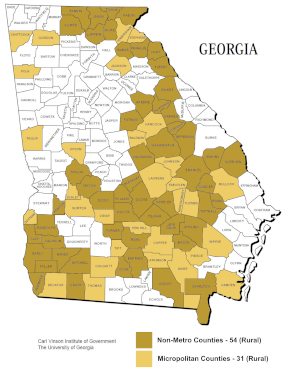
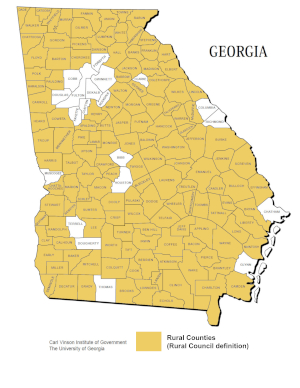
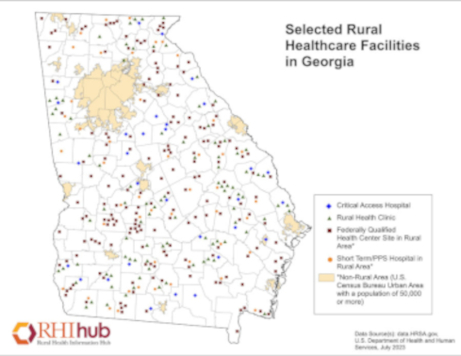
From: Rural Health Information Hub (for Georgia)
|
